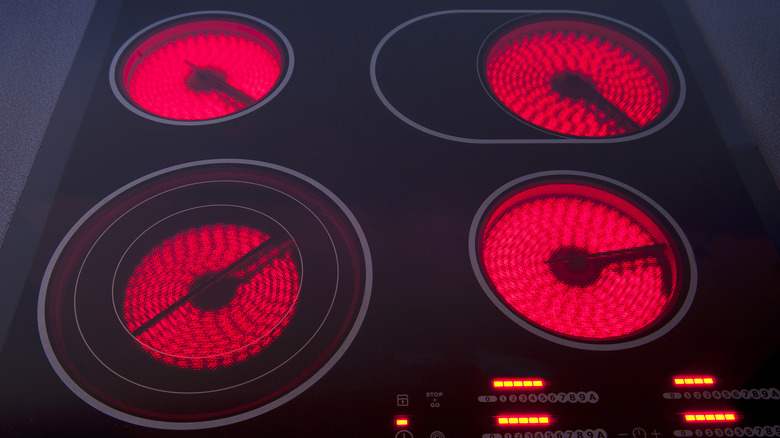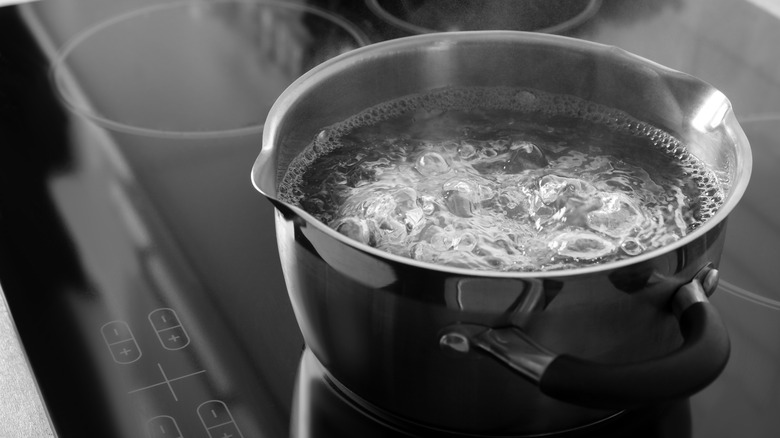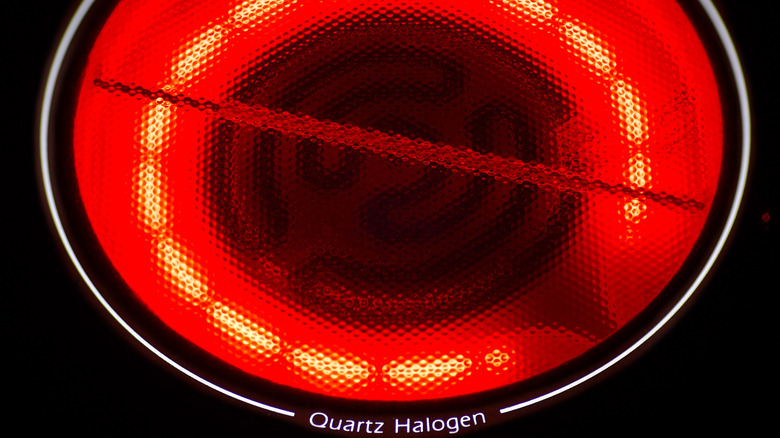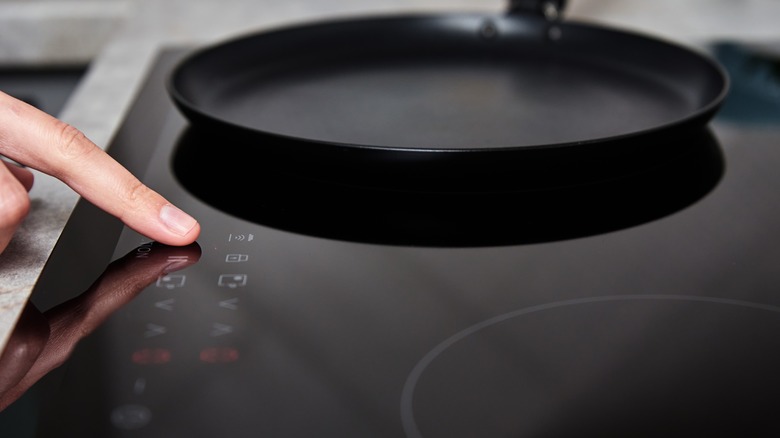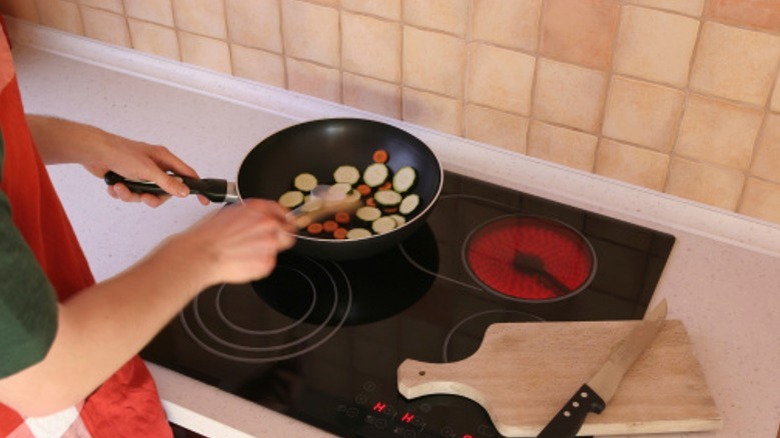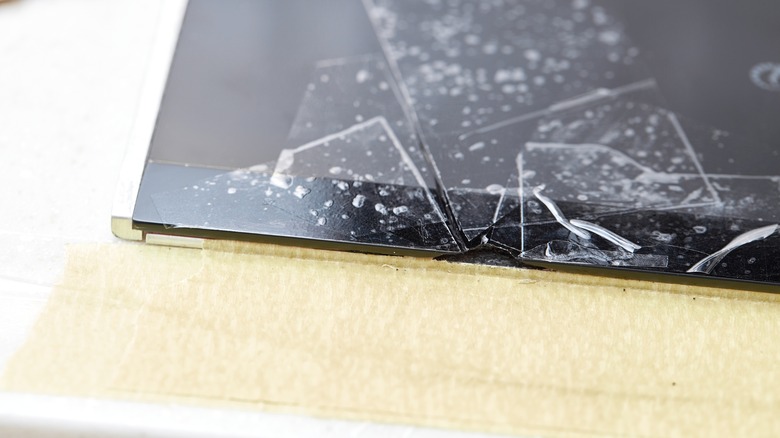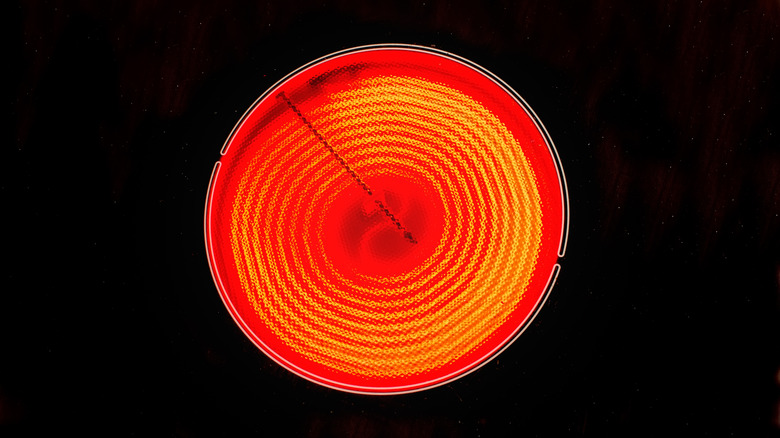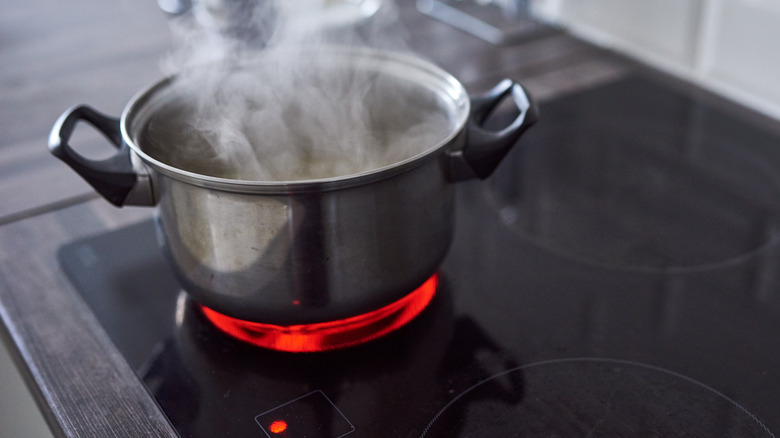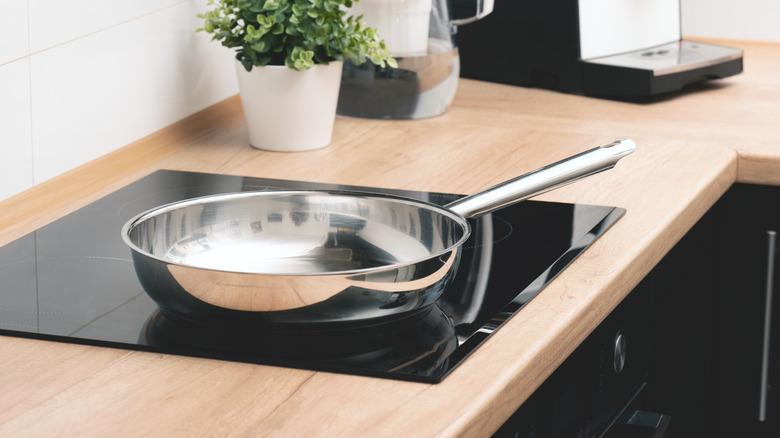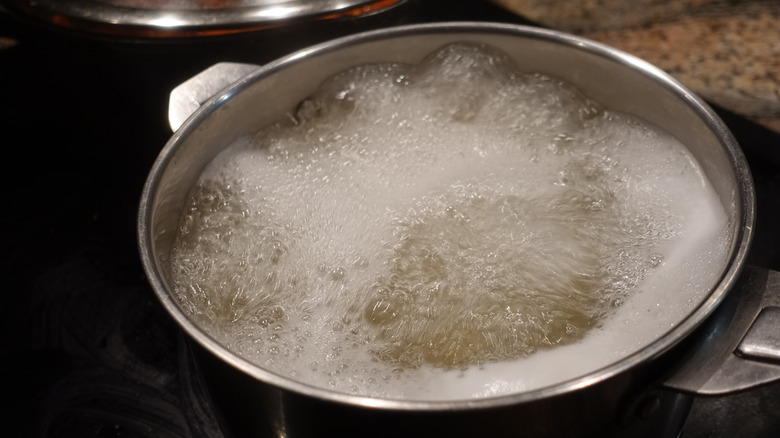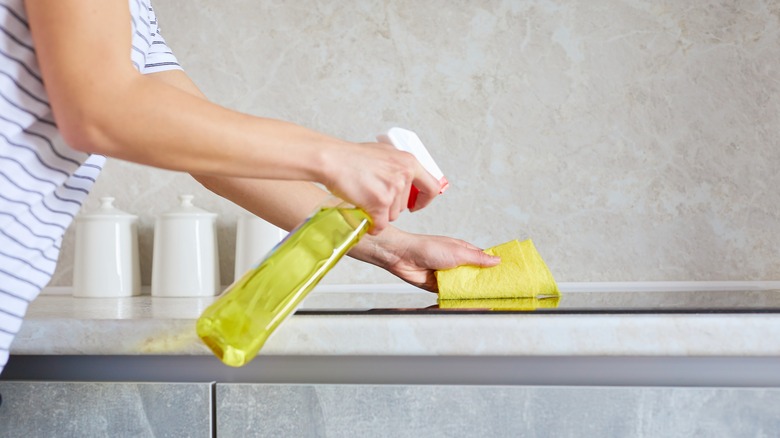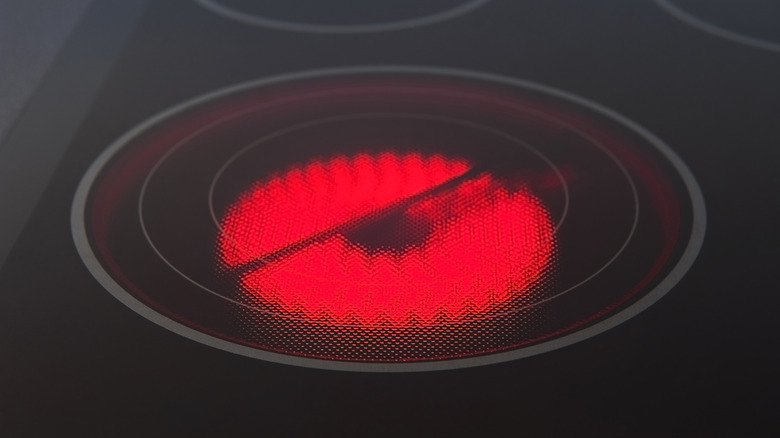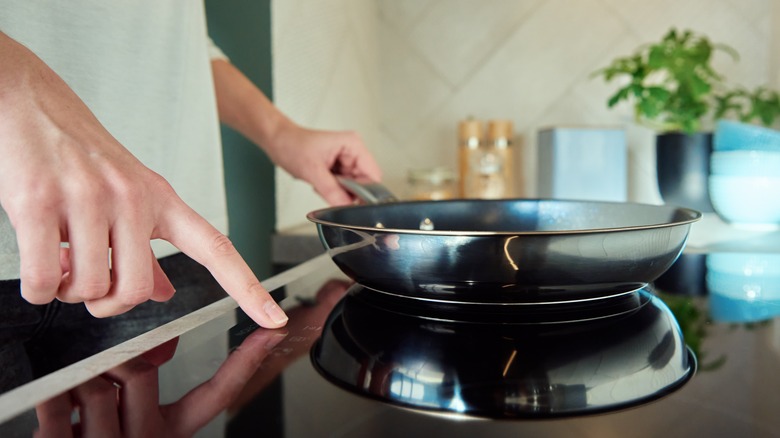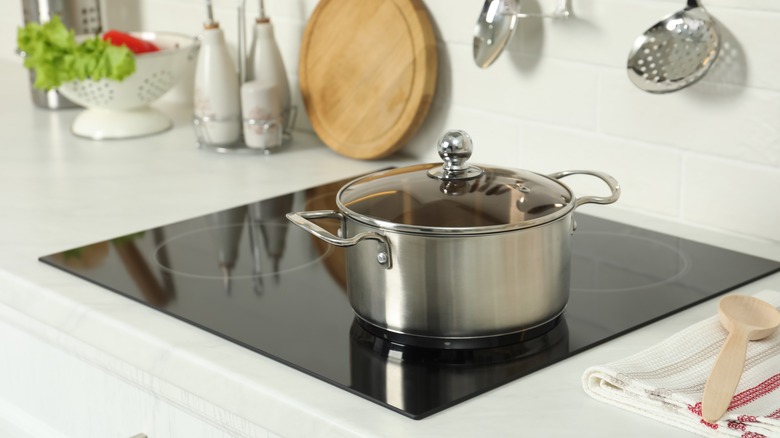14 Mistakes Everyone Makes When Cooking On A Halogen Cooktop
In the cooktop world, gas, electric, and induction technologies usually reign supreme. Halogen cooktops, though, shouldn't be discounted for their efficiency and ease of use. These cooktops generate heat through embedded halogen bulbs that emit a powerful red light under their glass-ceramic surface, which is turned on by the simple twist of a knob. This radiating heat then warms the glass-ceramic material very quickly, which in turn heats your pots and pans and cooks your food. Once you've finished cooking, the flat surface of these appliances means you can then simply wipe them clean.
While halogen cooktops are arguably less popular these days than they used to be, they're still the go-to option for many households. However, just because they're simple to use doesn't mean they're mistake-proof. Halogen cooktops can be surprisingly vulnerable appliances, with their glass-ceramic surface prone to becoming scratched or damaged if they're misused. The ultra-powerful heating technology also presents some issues and can pose a safety hazard if you're not careful. Luckily, your search for some guidance around your halogen cooktop is over — we're here to show you all the mistakes you need to avoid.
1. Not reading your instruction manual
Reading the instruction manual isn't just for nerds, folks — especially when you're using halogen cooktop technology. As halogen-based cooking is far less common these days than gas or induction methods, reading your instruction manual can help you get accustomed to how to use your appliance properly, especially when you can't rely on prior experiences to guide you.
Your instruction manual will guide you through the initial stages of working with your cooktop, helping you avoid early mistakes like not cleaning off packaging adhesive or using the wrong materials or solutions to do so, which can cause immediate damage to your appliance. It can also give you some useful guidance on the features of your cooktop and how to use it properly, as well as how the technology functions. Perhaps most importantly, though, your instruction manual will give you a huge amount of safety information, not to mention certain things to avoid doing. For example, halogen cooktops heat so quickly that certain types of glass and earthenware pans may be unsuitable for use and can shatter due to the rapid warming, creating a safety hazard. Fail to read your instruction manual, and you'll miss crucial tidbits like this.
2. Using the wrong pots and pans
The pots and pans you choose to use with your halogen cooktop will make or break your experience. Unlike gas cooktops, which are suited for use with pretty much any pan shape, halogen cooktops require flat-bottomed cookware to be effective. This is because the pan needs to lie flat on the glass surface to allow the heat from the halogen bulbs to be as effective as possible. If you use a curved pan, the heat won't connect with its base properly and instead just diffuse into your kitchen's atmosphere, wasting energy and time.
Flatness isn't the only thing you should be thinking about when picking your pots and pans, though — thickness is also a concern. If you have a thick pan, the heat is retained far more capably, and this heat is then better distributed up its sides, cooking your food way better. If you're using a thin pan, meanwhile, that heat then moves through the metal and escapes quicker. Thinner pans also generally suffer from a greater inconsistency of heat distribution, and you might find that you have more hot spots. This is especially problematic for halogen cooktops, with their high heat making it more likely that your food scorches.
3. Forgetting how quickly they heat up
For impatient chefs, halogen cooktops might be the best choice out there, primarily due to how quickly they heat up. While that might be a good thing to get your food on the go, it's less good for your general safety. Too many people flick their halogen cooktop too high while standing too close to it and are immediately shocked by the intense heat radiating from the bulbs. While this might at best cause minor discomfort, in the worst-case scenario, you might accidentally burn yourself.
The quick-heating capacity of your halogen cooktop can also pose a problem for your food. If you set it to high and start cooking, you might find that the chicken breast you're cooking has blackened on the outside in mere minutes, releasing plumes of smoke into your kitchen. We instead recommend that you take things slow with your halogen cooktop. Begin on a lower heat than you think you need and turn it up gradually until you reach your desired temperature. Additionally, make sure you're standing well back from your cooktop when you turn it on, to avoid any discomfort or burn risk.
4. Assuming they're exactly like other flat cooktops
With their super smooth surface and embedded technology, halogen cooktops are virtually indistinguishable from induction or electric models. There are a few key differences, though, that distinguish them — and if you've been using a different style of cooktop up until now, understanding those differences will save you some operational issues.
Cooking times can vary. For instance, when you're using an induction cooktop, your pans will heat pretty much instantly, thanks to the magnetic field created by the hob transferring to your cookware rapidly. Halogen cooktops, while quick-heating overall, do take a little longer than induction hobs, due to the radiating heat requiring more time to fully penetrate the pot. This means that a dish that could take less time on your induction cooktop will take longer on your halogen one. These machines can also vary in their ability to cool down quickly, and you might find that your halogen cooktop takes way longer to get cold than your former induction model. You may also find that certain pans that were off limits with your induction hob might be now compatible with a halogen cooktop, which could widen your scope considerably.
5. Not knowing your heat settings
Of all the styles of cooktops out there, halogen cooktops might have the steepest learning curve. This is largely down to the heat settings you're commonly supplied with. Unlike other flat cooktops, which give you a series of numbers to work with (or gas stoves, which quite literally allow you to see the intensity of your flame), halogen cooktops may just give you a few settings, allowing you to choose between high, medium, and low.
Fail to fully test what these heat settings mean, and you'll quickly find that your food is ruined. The high setting, as you'll have guessed by now, gives the highest heat. This is best for frying, searing, or stir-frying food or generating a rolling boil for water. Medium will give you a slower boil and enough heat to lightly brown food. Low, on the other hand, is pretty good for steaming rice or gently simmering water and is a good choice for poaching eggs. Luckily, most instruction manuals will give a clue as to what intensity of heat each of these settings produces, but it's still worth testing it out yourself to see how they affect your specific pans. A lot of halogen cooktops will allow you to set the heat somewhere between these benchmarks, so you can be a bit more specific.
6. Forgetting that they can shatter
Halogen cooktops are by no means impervious to damage. One of the main safety issues with halogen cooktops is their glass-ceramic surface. These toughened surfaces are built with heat in mind and can withstand temperatures of 1,300 degrees Fahrenheit or above. It's not so much the heat that will cause them to shatter, though, as it is heavy, clunky objects, like your favorite thick-bottomed pan. If you're too heavy-handed with placing your cookware down, you can end up shattering your ceramic surface.
Do this, and you might as well kiss your halogen cooktop goodbye. Shattering the surface will present you with an eye-watering repair bill, and as halogen cooking technology is slightly less common nowadays, you may struggle to find a replacement for your model in the first place. Thinking that you can just ignore it won't work, either, as it's highly unsafe to cook on a broken surface and can even put you at risk of electric shock if any liquid gets under the surface. If you do shatter your halogen cooktop, the smart thing to do is to disconnect it from your main power immediately and call a licensed professional to come and repair it.
7. Looking at your cooktop for too long
If you've ever used a halogen cooktop before, you'll have immediately noticed the bright red light they emit. While that light might be hypnotic, you'll want to avoid staring at it for too long. This intense light is produced by the halogen bulb that heats your pans, and although there's not enough direct evidence to prove that these bulbs specifically can damage your eyes, it's certainly the case that the infrared light they emit can pose problems. Research published in the Indian Journal of Ophthalmology observed that the protein in eye lenses is sensitive to infrared radiative light, and prolonged exposure may increase the risk of health issues like cataracts.
As such, it's probably best to avert your eyes while your cooktop is heating up, before you've had a chance to place your pan on it. There's no need to panic if your eye does catch it or to wear sunglasses or protective goggles while you cook (unless you want to protect your eyes from chopped onion fumes, that is). Just don't look directly at the halogen bulbs for long periods, and you should be fine.
8. Shifting your pots and pans too much
If you're the kind of person who shakes your pots and pans while you cook, you might need to switch things up with your halogen cooktop. Too many people like to flex their chef skills and shift their pans as a way to redistribute their food and ensure an even browning. When you do this on a halogen cooktop, though, you end up scraping your pan over the glass-ceramic surface. This can cause small scratches which can soon develop into much larger ones, and if you're especially heavy-handed, you might damage your cooktop to the point where it doesn't operate properly anymore.
Shifting your pots and pans around can also decenter them, which can create issues for heat distribution. Because the heating zones on halogen cooktops are relatively small, shifting them off-center will make it harder for your pots to get hot effectively. You may therefore need to rethink your cooking style entirely and get used to using utensils a bit more often to shift your food. While this can be a bit of a learning curve, you'll likely soon find that keeping your pan still saves you valuable arm strength and ensures an evenly cooked meal.
9. Not giving the burners time to cool down
Halogen cooktops are incredibly quick to heat up. The time they take to cool down, however, is a different story entirely. Halogen cooktops take far longer to cool after cooking than other stove styles, and while this can be helpful if you're trying to keep food hot, it's not so great if you're trying to clean the cooktop or render it safe to touch. One key mistake people make is trying to clean their halogen cooktop before it's cooled, which can lead to the cleaning solution steaming its fumes into your kitchen, or the heat potentially burning your hand.
This is all made even more complicated by the fact that some halogen cooktops may stay hot even when their bulbs have faded, meaning there's no visual cue to indicate that it still might be risky to touch. You should therefore always give your halogen cooktop adequate time to cool before you're tempted to touch it. Wait for at least 15 to 20 minutes to ensure that the heat has properly diffused. You should also ensure that you're paying attention to any warning lights on your appliance, which may indicate that it's unsafe to touch.
10. Getting parts of your cooktop wet
Halogen cooktops are constructed with spills in mind, and their flat surface means that any water or oil splatters can be wiped up easily (when the cooktop is cool, of course). However, this spill-safe surface doesn't mean that other parts of your machine are built to be waterproof. If any water works its way under the surface of the cooktop or into the grooves around its knobs, it could potentially cause your appliance to malfunction and break. The same issue can occur if you get any water near its electric plug.
Your machine's functionality isn't the only thing at stake here, either — your safety is, too. Water getting into its electrical components could create a risk of electric shocks. To that end, we would always recommend being as careful as possible with water around your appliance. We would also recommend keeping in mind how hot your pans are when you add water to them. If you pour cold water into a screamingly hot pan, the bubbling effect it can create can cause the liquid to spill out instantly, flooding your cooktop and potentially heightening the risk of damage.
11. Not cleaning your halogen cooktop correctly
As with all kitchen appliances, you'll need to keep your halogen cooktop as clean as possible to ensure it functions correctly. That's easier said than done, though — especially when you're using the wrong cleaning materials. Oven sprays and aggressive stain removers are unsuitable for use on your glass-ceramic surface, as their harsh chemicals can damage it. The same issue can occur when using inflexible or rough-surfaced cleaning cloths like scourers or metal pads, which will heavily scratch your cooktop.
Instead, you should always work with light cleaning solutions and soft materials and opt for specialist products wherever possible. Cream cleaners that are specifically designed for use with halogen cooktops are a great choice and will protect the build of your appliance. Natural cleaning solutions like lemon juice, white vinegar, or baking soda (or a combination of your choosing) are safe to use on glass-ceramic and clean without the use of man-made chemicals. Cloth-wise, you'll want to use a soft, pliable material that won't leave any scratches. You can't go wrong with a smooth microfiber cloth; leave your natural cleaning solution to do the heavy lifting on your stains, and then simply wipe it all away.
12. Placing your cookware off-center
Placement is important with halogen cooktops. While gas stoves provide you with a good amount of flexibility as to where you put your pan, and induction cooktops have large cooking zones to fit each type of pot, halogen cooktops give you neither. Instead, the cooking zones supplied on these appliances can be fairly limited, and therefore limiting, meaning that if your pan is even slightly off center, you'll end up with a half-cooked meal.
That's why you should be super careful about how you place your cookware. Make sure that your pan is dead center over the halogen lights to ensure that it heats evenly and effectively. Although it can be pretty tempting to use a bigger zone than your pan to give you a bit more space to maneuver, doing this can create two main issues. The first is that the heat generated may be too intense for your poor little pan and the meal you're cooking in it. The second is that this is a massive waste of energy, and you'll end up just kicking out a load of unused heat, spiking your electricity bill and making your kitchen insufferably hot.
13. Ignoring the safety lights on your appliance
The lights on your halogen cooktop are there for a reason, folks, and you should learn to pay attention to them. Halogen cooktops can be embedded with various lights, the most useful of which is an indicator to show you that the surface is still hot. This light will usually stay on long after you've turned off your machine, and it's there to prevent you from trying to touch or clean it. Ignoring it can put you at risk of burning your fingers. It's particularly important, too, as an indicator for people who may not have been in the kitchen while you were cooking to leave the cooktop alone.
Your halogen cooktop may also have a light that indicates when the appliance is switched on. Of course, you'll likely already know it's on, as the halogen bulbs will be emitting light to heat your food. That doesn't mean this light is redundant, though. If your stove is on an especially low setting, the light emitted may be imperceptible, but the hob may still be hot to the touch. This indicator light can also be useful to flag any power or connectivity issues you're having with your appliance.
14. Leaving your food on the cooktop after cooking
If you've made a meal that will have leftovers, decanting them from your hot cookware and putting them straight in the fridge is never a good idea. Placing hot food items in a cold refrigerator will create a large amount of condensation and raise the fridge's interior temperature, potentially contributing to bacterial growth. It can therefore feel like a smart idea to just leave your food in the pot until it's cooled, but if you're using a halogen cooktop, doing this can ruin the delicious results of your hard work.
Halogen cooktops take a way longer time to cool down than other stoves. Even if you've turned your appliance off, the residual heat from your cooking zone can continue to cook your food, potentially reducing its moisture content too much or burning it while you munch away at your dinner. Furthermore, leaving your food on a hot cooktop can end up keeping it in the "danger zone," the temperature range in which bacteria thrive, for longer.
Therefore, you should always remove your food from the cooktop after cooking. The best thing to do is to move it away from the area entirely, placing it on a heatproof mat or cutting board. If you don't have that option, move your pot to an unused heating zone on your appliance.
